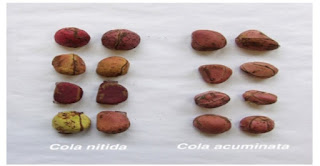HEMOGLOBIN
HEMOGLOBIN
Blood is a connective tissue in form of fluid.Red blood cells (erythrocytes) are the non-nucleated formed elements of blood. While hemoglobin is the iron containing protein in blood that is responsible for the transport of respiratory gases. It is a chromoprotein and has a molecular weight of 68000. Hemoglobin increases oxygen solubility in blood by about a hundredfold.
NORMAL HEMOGLOBIN CONTENT;Average hemoglobin content in blood is 14-16 g/dL.
The value varies depending upon the age and sex.
AGE
At birth : 25 g/dL
After 3rd month : 20 g/dL
After 1 year : 17 g/dL
From puberty onwards : 14 to 16 g/dL
SEX
In adult males : 15 g/dL
In adult females : 14.5g/dL.
STRUCTURE AND TYPES OF HEMOGLOBIN
Hemoglobin is a conjugated protein.
Its molecule is globular in shape, and is made up of 4 sub units. It consists of a protein combined with an iron containing pigment. The protein part is globin and the iron containing pigment is heme.
Globin;Contains four polypeptide chains. Among the four polypeptide chains, two are beta-chains and two are alpha-chains.
Heme;This is the iron containing pigment of the hemoglobin. Free heme is very sensitive to oxygen and, therefore, can bind with oxygen.
Types Of Normal Hemoglobin
1. Adult hemoglobin – HbA
2. Fetal hemoglobin – HbF
Both differ structurally and functionally.
FUNCTIONS OF HEMOGLOBIN
Transport of Oxygen;Oxygen binds with hemoglobin,resulting in the formation of oxyhemoglobin.Oxyhemoglobin is an unstable compound and the combination is reversible.When oxygen is released from oxyhemoglobin, it is called reduced hemoglobin.
Transport of Carbondioxide;When carbon dioxide binds with hemoglobin, carbhemoglobin is formed. It is also an unstable compound and the combination is reversible.By removal and transport of carbon dioxide from tissues to the lungs where it is expired, hemoglobin plays a role in maintenance of acid balance.
HEMOGLOBIN SYNTHESIS
Hemoglobin synthesis begins in the proerythroblast stage of RBCs development.
Heme is synthesized in the mitochondria.
Globin is synthesized in the ribosomes.
ABNORMAL HEMOGLOBIN
Abnormal hemoglobin are pathologic mutant forms of hemoglobin.Occurs due to structural changes in polypeptide chains caused by mutation in gene.Hemoglobin can bind to other molecules and result in formation of Abnormal Hemoglobin Derivatives some of which are:
Carboxyhemoglobin.
Methemoglobin.
Sulfhemoglobin.
HEMOLYSIS
Red blood cells have a lifespan of 120days.They are destroyed in the reticuloendothelial system along with hemoglobin.Hemoglobin is split into heme and globin.
Globin is reutilized for hemoglobin synthesis.
Heme is eventually broken iron and prophyrin.
Iron is stored in the body as ferritin and hemosiderin.
Porphyrin is eventually broken to form biliverdin which would be converted to bilirubin (bile pigment).
PATHOPHYSIOLOGY
Anemia
The most common blood disorder is Anemia. It is caused by too few red blood cells or too little hemoglobin in blood.
The most common symptom is fatigue.
Aplastic anemia can cause fever, and skin rashes.
Folic acid deficiency anemia irritability and diarrhea.
Hemolytic anemia can cause jaundice, dark urine, a fever, and abdominal pain.
Sickle cell anemia can cause painful swelling in the feet and hands, as well as fatigue and jaundice.
Treatment includes iron supplements taken by mouth, transfusion of RBCs, folic acid and Vit. B12 supplements.
REFERENCES
• Arthur C. Guyton and John E. Hall. Guyton and Hall textbook of medical physiology (11th edition), 419.
• K. Sembulingam and Prema Sembulingam. Essential of Medical Physiology. (6th edition), 45-78.
• Magdi Sabry. Human Physiology for Medical Students. Blood and Body Fluids (fourth edition), 33.




Original contribution
ReplyDeleteThanks
Delete